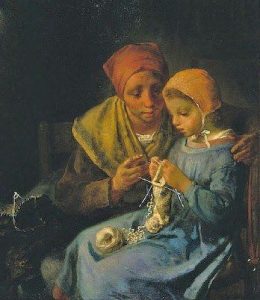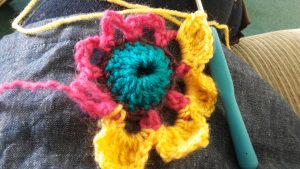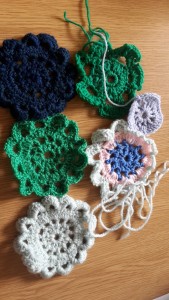Emma – Student Support Officer
I was ‘taught’ to knit by my mother. Her way of teaching was to show me how to do it, take it off me when it went wrong and then despair altogether. Unsuprisingly I didn’t persevere with it. However, when we lived in New Zealand for a year in 1993 I was concerned to see that it was expected that everyone could and would knit. It was almost impossible to buy jumpers in the shops and wool was ridiculously cheap and plentiful (five sheep per person) and school children wore home made jumpers and cardigans. Having exhausted my options for getting someone else to knit them I joined the local library and took out the Usborne book ‘How to Knit’. It was brilliant and with a bit of help from friends I made jumpers for all the whole family – whether they liked it or not. Once back from New Zealand I let my skills lapse until very recently when I discovered crochet and am now – pun intended – hooked.
Teri – Administrative Assistant
Other than creating wonky scarves and a single chain of crochet resembling a plait when I was in primary school I would consider myself a complete beginner. I find watching knitting and crochet fairly therapeutic so when there was the opportunity to actually get involved I was more than happy (and slightly apprehensive) to get stuck in. I decided to learn crochet as I had spent weeks watching a couple of colleagues create really pretty flowers in a considerably short space of time. What struck me first was how remarkably simple it was/is to create these flowers once you’ve got the basics (which aren’t that hard!). After the initial bit of effort and paying attention the payoff is massive, before long you are able to create something that looks pretty and complete. I really enjoy being able to take part in an activity that although it occupies part of your concentration and focus you can still socialise and talk. It really is the perfect group activity (once you’ve figured out the basics!). It also makes sure I get away from my desk at lunch time, I have a break from work, I don’t think about work and take part in an activity that is calming and sociable; it’s almost like a reset so that I’m able to regroup for work in the afternoon.
Gemma – Recruitment and Events Coordinator
Knitting is always something I associate with my Grandma. She had taught me how to knit the basic stitch when I was about 5 years old, but I had never really got into it. I remember being mesmerised by the speed in which her needles seemed to weave, the clicking of the metal and the rapidly growing garment, yet it always seemed like something more associated with an older generation and therefore out of reach. At the age of 23, my Grandpa had a stroke. As he had to spend a lot of time in hospital, my Grandma found herself on her own for the first time in the whole of their marriage. To try and give her something to keep her occupied, I found her a pattern and asked her if she wouldn’t mind knitting me a cardigan. Once it was finished she told me how comforting she had found it to be knitting again and to have something to concentrate on, whilst everything was going on out of her control.
A year later, I found out a friend of mine was expecting a baby and so I seized the opportunity to take up knitting. I was shown how to cast on, knit and purl and I just knitted and knitted. The first thing I made was just one long piece of straight knitting (a knitted bump warmer), which I took everywhere with me, taking every opportunity to add to it and get absorbed by the therapeutic act. Since then, I have knitted a number of different things, teaching myself along the way. I find that suffering from depression means it is hard to engulf myself in anything, but knitting (as with sewing) allows me that break from my wandering thoughts. When I’m working on a project, I feel excited to return to it, reluctant to put it down, similar to the feeling of reading a good book. When I’m knitting and watching TV, the knitting stops me feeling anxious that I’m wasting my time. And the great sense of achievement I get when I can physically see what I have created, is not a feeling I tend to experience by any other means.
Megan – Postgraduate Administrative Assistant
My brother and I are 13 months apart in age, and occupying us both as children could be pretty challenging for my poor mum, especially on trips.
On a family holiday (I want to say to the Isle of Wight, but we are talking over 20 years ago) she was faced with exactly this challenge when taking us both on a ferry to our destination. My brother was pretty content to run up and down the deck of the boat, but I suffered dreadfully with motion sickness, and had to be distracted to prevent temper tantrums.On a little wooden bench, my mum presented me with a “my first knitting” type of kit.
I very much doubt I completed much of the little scarf myself, undoubtedly thrusting the red plastic needles at my mum in frustration whenever I got into a tangle, but to this day knitting and crochet still keep me distracted for hours, and I love to relax on my lunch breaks or in the evening with crafty little projects. They are still the perfect distraction.
 re still out there but increasingly we’re becoming members of online communities. I’m part of crochet clubs, reading clubs, groups for my home town, wellbeing forums and a number of arts and crafts groups. All of these are brilliant and I can feel part of a community as, between us (me and other keen participators out there) we work out tricky stitch problems or why that granny square has only 3 corners – you know the kind of thing! However, my online community don’t chat to me as I crochet or admire my lovely new wool and they can’t be there to just chat about the stuff our days are made of, because they are busy with their own lives, dipping into and out of the online communities.
re still out there but increasingly we’re becoming members of online communities. I’m part of crochet clubs, reading clubs, groups for my home town, wellbeing forums and a number of arts and crafts groups. All of these are brilliant and I can feel part of a community as, between us (me and other keen participators out there) we work out tricky stitch problems or why that granny square has only 3 corners – you know the kind of thing! However, my online community don’t chat to me as I crochet or admire my lovely new wool and they can’t be there to just chat about the stuff our days are made of, because they are busy with their own lives, dipping into and out of the online communities.
 ten, I look around at us all knitting and crocheting in the common room and am reminded of how many artists have chosen the knitter as inspiration. Is it the tranquility of features absorbed in the task? Is it something about the posture of the knitter, the bent neck, the symmetry of hands at work? Is it perhaps the contrast between sitter and their environment? For us, it is all of these things and a great deal more.
ten, I look around at us all knitting and crocheting in the common room and am reminded of how many artists have chosen the knitter as inspiration. Is it the tranquility of features absorbed in the task? Is it something about the posture of the knitter, the bent neck, the symmetry of hands at work? Is it perhaps the contrast between sitter and their environment? For us, it is all of these things and a great deal more.

